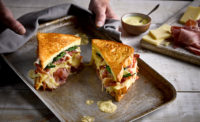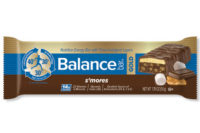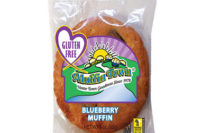Baked goods have been a part of peoples’ diet for thousands of years, far longer than golfers have been hitting a little ball across a grassy surface with a long stick. As ingredients, production methods, distribution and a host of other factors have evolved, consumers at all income levels have been able to enjoy staples like breads and rolls, as well as sweet treats like cookies and pies.
And bakers throughout the ages have been eager to develop products that meet consumers’ changing wants and needs. Today, this means baked goods containing fewer calories and less salt and sugar; tasty new flavors; and smaller sizes for portion-controlled eating.
Harlan Bakeries LLC, for instance, relaunched its Nature’s Grain Carb Check bagel earlier this month in New Orleans, during the International Dairy-Deli-Bakery Association’s (IDDBA) Dairy-Deli-Bake 2012. “We had it on the market a while ago, but had to withdraw it because we had some ingredient shortages,” says Joe Latouf, executive vice president of sales and marketing for the Avon, Ind., bakery.
Consumer demand for the bagel, which has fewer calories, fewer carbohydrates and more fiber than regular bagels, prompted the company to resurrect it. “It’s really got a wonderful following on social media and on the Internet via consumers who have a real love affair with the product,” says Latouf, adding that someone even created a “Save the Bagel” pinboard on Pinterest, an online pinboard. “We’re hoping, of course, that the product will go national.”
According to Latouf, the Carb Check bagel is available in three formulations: Original; multigrain; and whole wheat. A five-unit package retails for around $4.
Bagel lovers with a sweet tooth, meanwhile, can check out the Original Bagel Co.’s new handmade Cinnamon Crunch bagel, which is topped with a proprietary blend of turbinado and pastry sugars. “Original Bagel is responding to consumers who desire an inexpensive ‘treat’ during the day with our new handmade cinnamon crunch bagel,” says David Harris, president of the small craft bakery in West Caldwell, N.J. “This is a great bagel option for consumers looking for a ‘sweet treat.’”
The 5-oz. bagel will be available in the continental United States at a single-unit price ranging from 89 cents to $1.39.
Strong or soft?
“In 2012, Original Bagel continues to see strong demand and growth rates similar to [those of] 2011,” says Harris, noting that the majority of the company’s customers experienced solid repeat business and 5- to 8% year-over-year growth last year.
To keep up with customer demand, Original Bagel has been “carefully expanding,” says Harris. “In June 2012, we’re installing a new Peerless mixer, and we’re also increasing from a one-shift, seven-day bakery to a two-shift, six- or seven-day bakery.”
Others, however, are less optimistic about this category’s performance in the coming year. Harlan Bakeries’ Latouf says the bagel category is “flat to declining,” and was only helped last year by the introduction of bagel thins by a number of bagel makers. “In a general sense, the typical six-pack bagels or packaged mini bagels are all experiencing some softness around the country,” he says, citing dietary concerns, cost, the economy and bagel alternatives as possible reasons for this softness.
Muffins for all
Like the bagel category, the muffin segment hasn’t been “immune to the economic challenges affecting the broader grocery industry,” says Jamie Griffis, associate brand manager for Dawn Food Products Inc., Jackson, Mich., whose consumer brands include Weight Watchers Sweet Baked Goods. “In 2011 and into 2012, we saw pricing actions across most segments in the sweet bakery category, as manufacturers adjusted to cost fluctuations, which led to a decline in overall selling units. The result is a heightened consumer focus on product quality and value. That is one of the main reasons we re-launched the new Weight Watchers Muffins with a higher piece count (four muffins versus three previously) for the same price in-store.”
The re-launched line features “sensible versions” of two popular muffin varieties—blueberry and chocolate. Topped with coarse sugar crystals and filled with real wild blueberries, Weight Watchers Blueberry Muffin has 5 g. of fiber, 160 calories and a PointsPlus value of 4. Weight Watchers Double Chocolate Muffin delivers a burst of real chocolate flavor from larger chocolate chips and a slight sweetness from coarse sugar crystals on its top. It, too, has just 160 calories and a PointsPlus value of 4, as well as 6 g. of fiber.
Both varieties are individually-wrapped for convenience and portion control, and are available nationwide at most major grocery stores for an average retail price of $3.49.
Harlan Bakeries, whose baked goods also include breads, rolls, pies and cakes, recently added the Gourmet Muffin Top to its offerings. “It’s made with Greek-style yogurt and doing exceptionally well,” says Latouf. “The advantage of using Greek-style yogurt is that it reduces the carbohydrate count and increases the protein levels.”
Available in blueberry, lemon poppy, banana nut and chocolate, the nonbranded muffin tops are packaged in clamshells for in-store bakeries. The suggested retail for a six-count package is $3.99.
Consumers looking for a better-for-you version of the English muffin can sample a new offering this summer from Van’s Natural Foods, Vernon, Calif. Available in Multigrain and Honey Wheat, Van’s 8 Whole Grains English Muffins are made with eight whole grains and seeds, including whole millet, buckwheat, flax and sunflower seeds, and are frozen immediately after baking to maintain freshness without preservatives. Both flavors provide 5 g. of protein and 3 g. of fiber per serving. Twelve-oz. packages will be available at grocery stores nationwide for a suggest retail price of $4.29.
The pie pros
Many of the new ready-to-eat pies introduced by leading bakers address key consumer trends discussed in “What’s in Store 2012,” a publication released last fall by the International Dairy-Deli-Bakery Association (IDDBA). According to the report, consumers are turning to in-store supermarket bakeries for mini pies, cupcakes and cake pops because they cost less and offer smaller portions; for gluten-free products; and for a wider array of sweet desserts.
Winston-Salem, N.C.-based Krispy Kreme, whose sweet treats can be found in hundreds of Krispy Kreme stores and thousands of grocery, convenience and mass merchant stores across the U.S., recently introduced three 4-oz. pies with an Original Glaze-topped crust.
The company launched a Glazed Chocolate Pie with a smooth chocolate filling in November. It comes in an individual snack pack (for $1.09) and in boxes with six individually-wrapped pies (approximately $8) at participating mass merchants, grocery and convenience stores.
In April, Krispy Kreme introduced a Glazed Lemon Pie, the first of its new seasonal glazed fruit pies. The pie has a zesty sweet lemon KREME filling. A Glazed Peach Pie with a peach filling followed in June. Both single-serving pies retail for $1.09 and are available for a limited time at participating mass merchants, grocery and convenience stores.
“We are committed to adding new and exciting treats to our packaged product line,” says Mark LaBrecque, Krispy Kreme’s senior director—U.S. marketing activation, in a press release. “The Glazed Lemon and Peach pies are the first seasonal flavors we are excited to share with fans of our popular chocolate-, apple- and cherry-filled pies.”
Crave Foods Inc. in Los Angeles, meanwhile, offers a variety of 5-oz. gluten-free pies for consumers with dietary concerns or who are interested in portion-control or better-for-you treats. Individual Apple Cream, Blueberry Cream, Pecan, Custard and Sweet Potato Pies are available for a suggest retail price of $2.49.
The company also offers 9-in., 32-oz. Gluten Free Apple, Pecan, Sweet Potato and Pumpkin Pies at a suggest retail price of $7.99.
Says Crave president Riaz Surti, “[Crave] is the first company to use garbanzo bean flour as the main ingredient in all its pies. The crust is not only flakey, but it’s great tasting without the odd after taste other gluten-free products have.”
Surti says “the gluten-free pie category was nonexistent until the introduction of Crave Pies in fall 2011. Crave Pies quickly outsold the frozen pies in its category.” Depending on the retail outlet, Crave Pies are available frozen or unfrozen.
Large Crave Pies are available in California and Arizona at Albertsons, Gelson’s Markets, Bristol Farms and Whole Foods Markets. Individual Gluten Free pies are available in many independent natural grocery stores in Georgia, Louisiana and Texas and at H-E-Bstores in Texas. In July, Crave’s entire line of Gluten Free pies also will be available at Wegmans stores on the East Coast.
Surti says the company plans to expand its distribution to 2,000 stores nationwide by summer 2012, up from its current nationwide distribution of 1,000 stores. He adds that the company also is in the process of rebranding its products to The Original Crave Foods Co. and giving its new packaging an edgy, retro look.
When it comes to that American dessert staple, the fruit pie, consumers are constantly looking for new flavors, says Latouf of Harlan Bakeries, one of the largest contract pie manufacturers in the country. “Requests come in regularly for new and innovative pie formulations that use different and unusual blends of fruit, especially around harvest season,” he says. “Everyone’s looking to break the stranglehold pumpkin pie has on the season for a couple of reasons—pumpkins are in short supply again this year and expensive.”
But pumpkin isn’t the only fruit likely to be in short supply this year. “The biggest news in the pie category is the devastation to this year’s cherry crop, especially in Michigan” says Latouf. “The mild winter caused most of the orchards to bloom early, and then a freeze came back, really devastating the crops. That’s going to create a significant shortage of cherries, as well as drive prices through the roof.”
Latouf’s expectations for the pie category in 2012 is mixed. “My read is that the in-store bakery, depending on the retailer, is flat to down 2% or 3%,” he says. “The freezer-case business, on the other hand, is up 3% to 5%.”
Despite the potential challenges facing pie makers this year, consumers will still find plenty of new baked goods in grocery stores in the coming months, whether they’re looking for a nutritious treat to help them play 18 holes or a decadent reward for hitting their first-ever hole in one.









